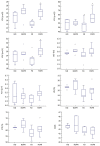Lactobacillus rhamnosus PB01 (DSM 14870) supplementation affects markers of sperm kinematic parameters in a diet-induced obesity mice model
- PMID: 29016685
- PMCID: PMC5634625
- DOI: 10.1371/journal.pone.0185964
Lactobacillus rhamnosus PB01 (DSM 14870) supplementation affects markers of sperm kinematic parameters in a diet-induced obesity mice model
Abstract
Probiotics have been proposed as alternatives to pharmacological products in several medical conditions including the modulation of obesity, which is frequently associated with poor semen quality. However, effects of probiotics on male fertility have been less investigated. This study assessed the effect of Lactobacillus rhamnosus PB01 (DSM-14870) on sperm kinematic parameters in Normal-weight (NW) and diet-induced obese (DIO) models. NW and DIO C57BL/6NTac mice were divided into two subgroups with or without a single daily dose (1x109CFU) of L. rhamnosus for four weeks. Sperm motility and kinematics together with blood lipid profiles and reproductive hormone levels were assessed using the sperm class analyzer system. Probiotic supplementation increased serum testosterone, LH and FSH levels in both NW and DIO groups resulting in significantly (P<0.05) higher velocity (VSL, VCL and VAP) and percentages of progressively motile sperm and significantly lower percentages of immotile sperm. Other kinematic parameters (Lin, STR, ALH and BCF) were also increased in both probiotic supplemented DIO and NW groups at the 10% level of significance. Probiotic supplemented DIO mice demonstrated significantly higher percentages of progressively motile sperm versus DIO controls. This study demonstrated the potential of L. rhamnosus PB01 as a regulatory agent with positive effects on weight loss and reproductive-hormones, significantly improving sperm motility and kinematic parameters in male DIO models.
Conflict of interest statement
Figures



References
-
- Ljiljak D, Milaković TT, Severinski NS, Kuna KB, Radojčić A. Sperm Cell in ART In: Wu B, editor. Advances in embrtyo transfer. InTech; 2012. pp. 65–73.
-
- Hull MG, Glazener CM, Kelly NJ, Conway DI, Foster PA, Hinton RA, et al. Population study of causes, treatment, and outcome of infertility. Br Med J (Clin Res Ed). 1985;291: 1693–7. Available: http://www.pubmedcentral.nih.gov/articlerender.fcgi?artid=1418755&tool=p... - PMC - PubMed
-
- Magnusdottir E V, Thorsteinsson T, Thorsteinsdottir S, Heimisdottir M, Olafsdottir K. Persistent organochlorines, sedentary occupation, obesity and human male subfertility. Hum Reprod. 2005;20: 208–15. Available: http://www.ncbi.nlm.nih.gov/pubmed/15567884 doi: 10.1093/humrep/deh569 - DOI - PubMed
-
- Fejes I, Koloszár S, Závaczki Z, Daru J, Szöllösi J, Pál A. Effect of body weight on testosterone/estradiol ratio in oligozoospermic patients. Arch Androl. 2006;52: 97–102. doi: 10.1080/01485010500315479 - DOI - PubMed
-
- Fejes I, Koloszár S, Szöllosi J, Závaczki Z, Pál A. Is semen quality affected by male body fat distribution? Andrologia. 2005;37: 155–9. Available: http://www.ncbi.nlm.nih.gov/pubmed/16266392 doi: 10.1111/j.1439-0272.2005.00671.x - DOI - PubMed
MeSH terms
Substances
LinkOut - more resources
Full Text Sources
Other Literature Sources
Medical
Miscellaneous

